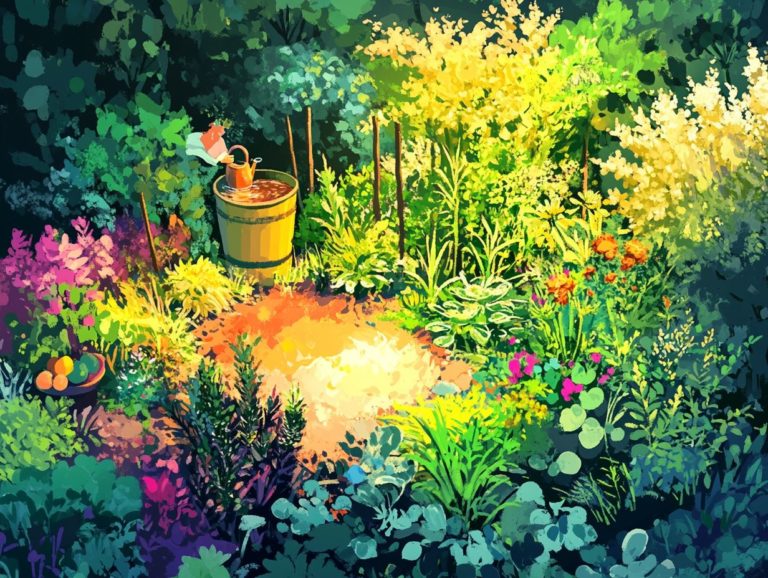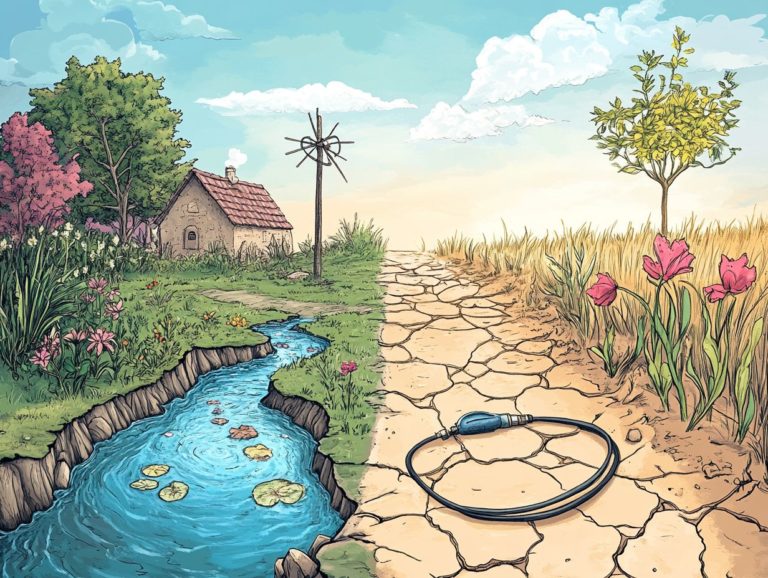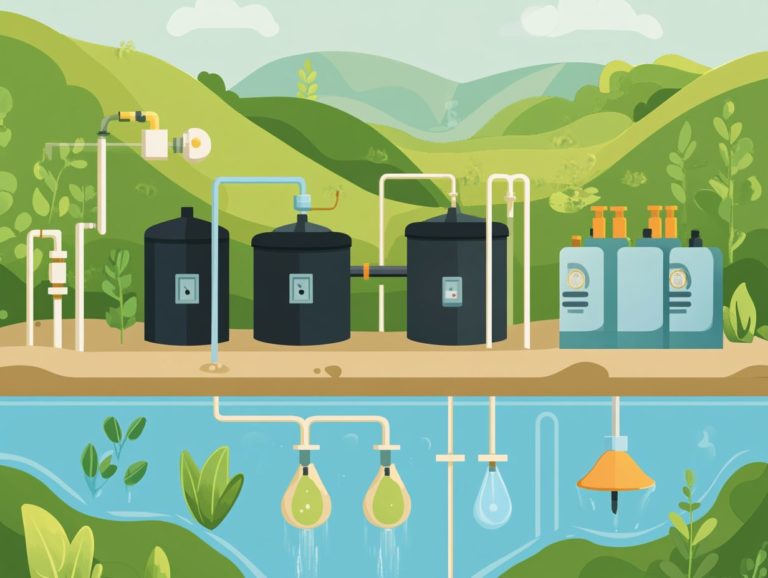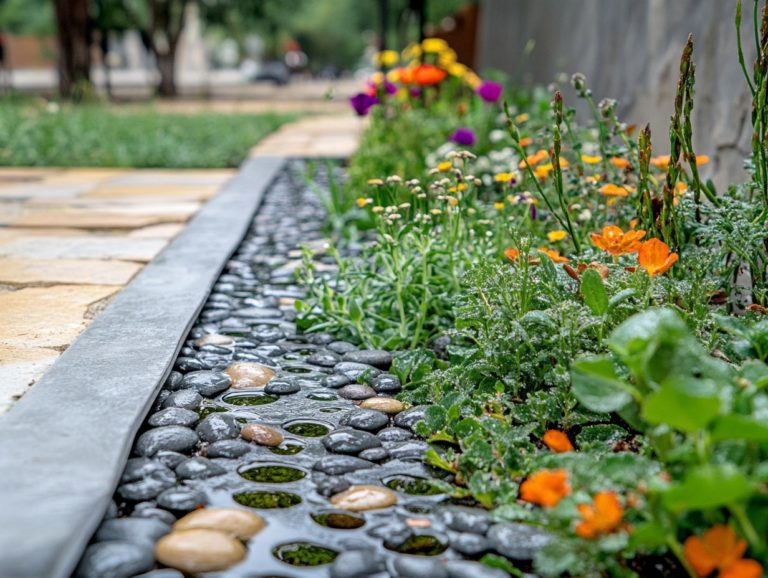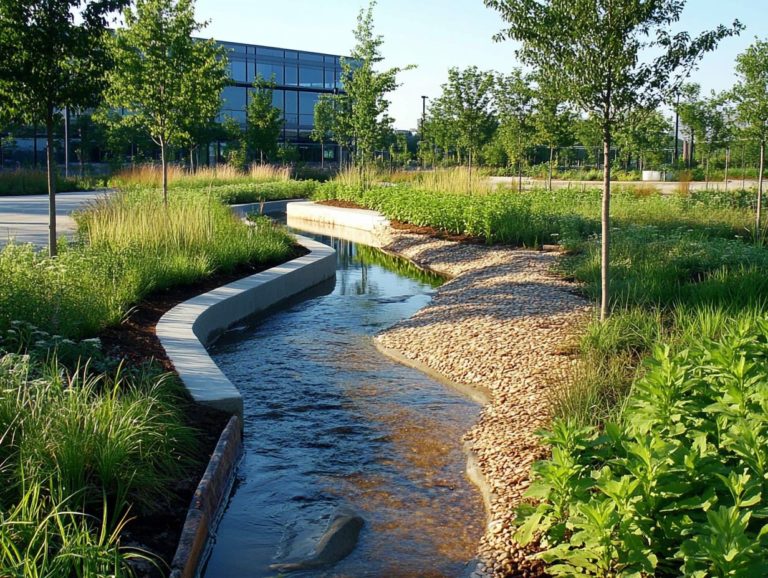5 Creative Ways to Collect Rainwater
Collecting rainwater transcends mere eco-friendly trends; it emerges as a practical solution for sustainable living.
From innovative rain barrels to exquisite rain gardens, countless methods exist for harnessing nature s generous offerings. Get ready to explore five exciting techniques for collecting rainwater! This article also tackles common misconceptions, outlines practical uses, and provides essential tips to help you embark on this journey.
Start making a positive impact on the planet today while saving money!
Contents
- Key Takeaways:
- 1. Rain Barrels
- 2. Rain Chains
- 3. Rainwater Harvesting Systems
- 4. Rain Gardens
- 5. Green Roofs
- Why Should You Collect Rainwater?
- Frequently Asked Questions
- What are 5 creative ways to collect rainwater?
- How can collecting rainwater benefit the environment?
- Is it legal to collect rainwater?
- What are the cost benefits of collecting rainwater?
- How can I ensure the collected rainwater is safe to use?
- Are there any tips for maintaining my rainwater collection system?
Key Takeaways:
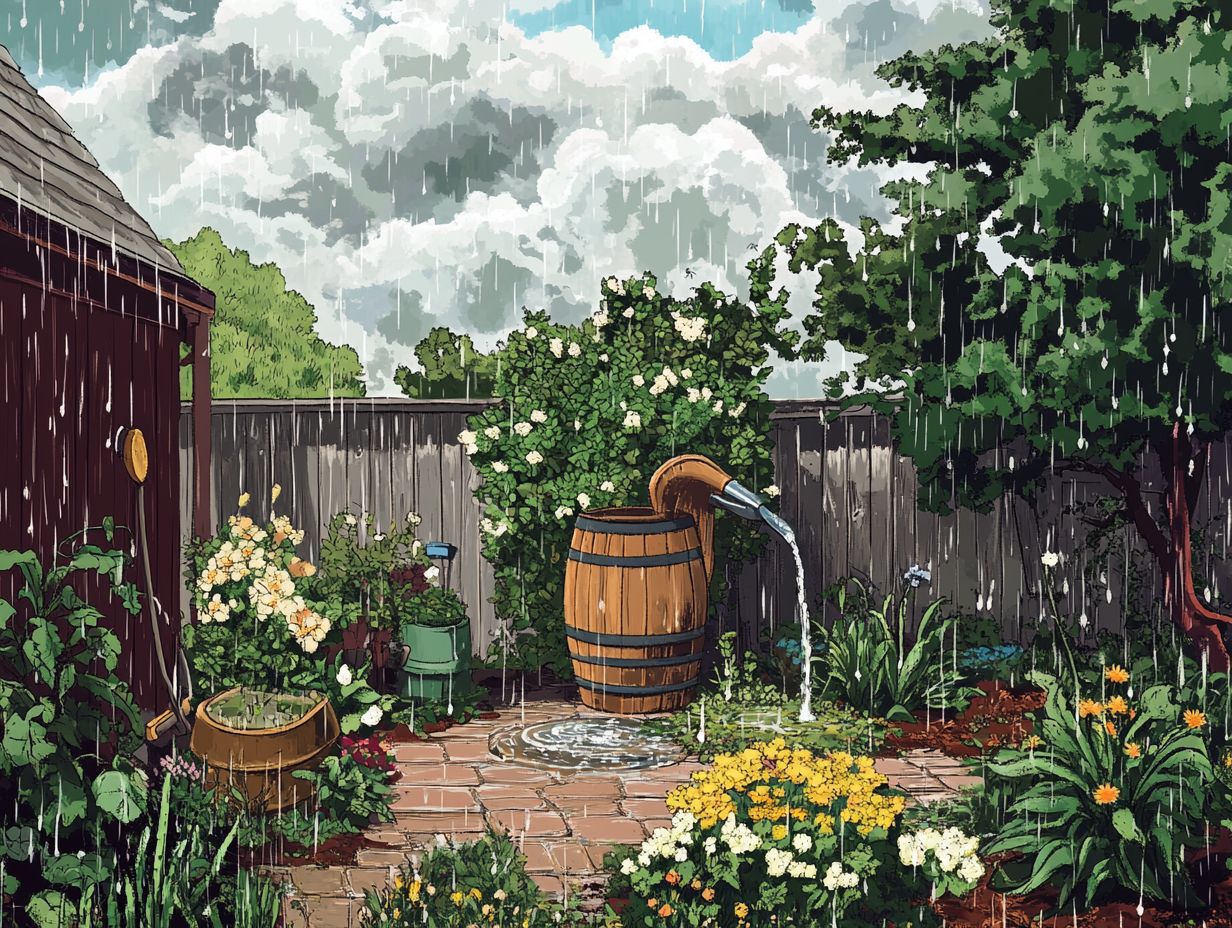
- Save money and the environment by collecting rainwater with simple and creative methods like rain barrels, chains, and harvesting systems.
- Create beautiful and functional rain gardens and green roofs to collect and utilize rainwater for gardening or household use.
- Clear up common misconceptions about collecting rainwater and learn about the various ways it can be used to benefit both your wallet and the planet.
1. Rain Barrels
Rain barrels are a smart and stylish way to collect rainwater for your garden. They help conserve water and improve water quality in urban areas.
By capturing stormwater runoff, you can alleviate pressure on local drainage systems, significantly reducing the risk of flooding and water pollution. Each rain barrel can typically store hundreds of gallons, making it an astute choice for households eager to optimize water efficiency.
To ensure that the water collected is pristine, it s crucial to maintain clean gutters. This is a part of responsible water management, protecting the quality of your stored water.
Choose a rain barrel that fits your garden s needs and complements your outdoor space. These barrels can nourish both indoor and outdoor plants while beautifully enhancing your landscape’s visual appeal.
2. Rain Chains
Rain chains offer a stunning and practical alternative to traditional downspouts. They effortlessly guide collected rainwater to your gardens or rain barrels.
Not only do they enhance the beauty of your landscape, but they also contribute to vital water conservation efforts. These delightful features come in various designs, allowing you to choose a style that perfectly complements your outdoor aesthetic.
But it s not just about looks; rain chains attract local wildlife, providing a refreshing source of water for birds and beneficial insects. This supports biodiversity in urban areas.
By integrating rain chains into your rainwater harvesting systems, you not only mitigate runoff but also create opportunities to collect rainwater for irrigation or other uses. Innovative urban designs even incorporate rain chains into vertical gardens or wall-mounted systems.
3. Rainwater Harvesting Systems
Rainwater harvesting systems are well-designed setups that efficiently collect and store rainwater for various uses. This includes irrigating outdoor plants and nurturing indoor greenery.
These systems typically comprise several essential components, including places where rainwater collects, conveyance systems, storage options, and treatment methods. For example, if space is at a premium, underground storage systems provide an excellent solution.
To ensure water quality, integrating filters and committing to regular maintenance will keep your harvested water free from contaminants. You’ll find that collected rainwater can be used for irrigation in your gardens, washing vehicles, or even flushing toilets indoors.
4. Rain Gardens
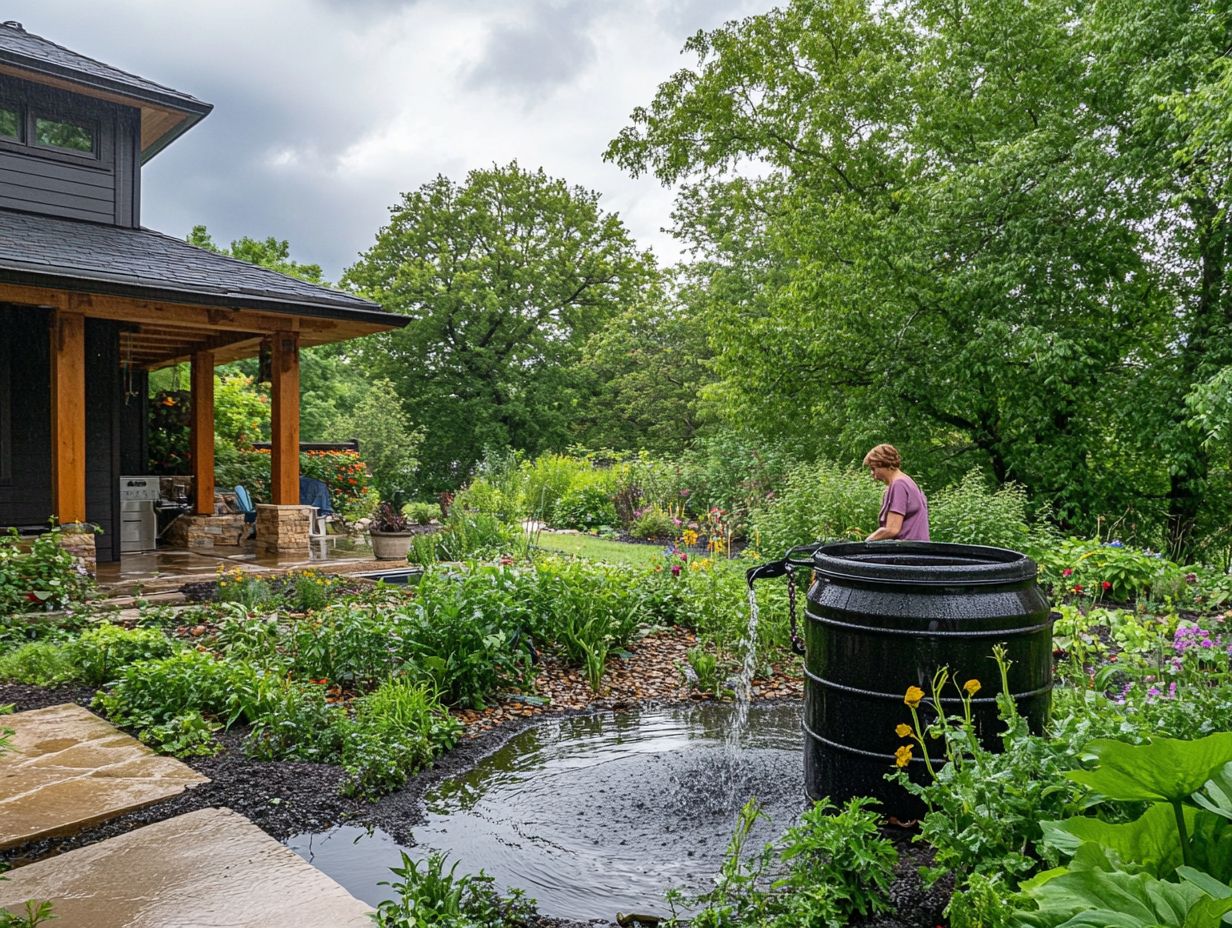
Rain gardens are exquisitely crafted landscapes that capture and filter stormwater runoff. They enhance water quality while providing a haven for wildlife and elevating the aesthetics of your surroundings. These gardens are essential for managing water effectively.
By allowing rainwater to permeate the ground, they play a pivotal role in urban stormwater management, significantly reducing the risks of flooding and erosion. When embarking on the installation journey, meticulous planning is essential. Selecting appropriate locations with ample sunlight and excellent drainage is crucial. Additionally, keeping your gutters clean is vital; any debris can block water flow and undermine the garden’s functionality.
Opting for native plants is a game changer for the success of these gardens. Native plants thrive in local conditions, demand less upkeep, and support the local ecosystem by attracting beneficial pollinators while efficiently soaking up excess rainwater.
5. Green Roofs
Green roofs represent a cutting-edge sustainable building technique that harnesses the power of vegetation. They absorb rainwater, contributing to water conservation while delivering a myriad of environmental benefits in urban landscapes. Green roofs play a crucial role in reducing the heat island effect and enhancing air quality.
There are three types of green roofs: extensive, semi-intensive, and intensive. Each type offers unique advantages based on the depth of soil needed for different plants. Integrating green roofs in cities helps manage stormwater runoff, alleviating pressure on drainage systems and mitigating flood risks.
Implementing innovative techniques like modular green roof systems and advanced irrigation controls can optimize water retention and use rainwater more effectively. Meanwhile, traditional methods, such as choosing native plant species, enhance biodiversity and create natural habitats.
Together, these strategies not only facilitate rainwater capture but also cultivate vibrant, eco-friendly spaces that bolster the overall resilience of urban environments.
Why Should You Collect Rainwater?
Collecting rainwater is a smart and essential practice that gives you the power to reuse this precious resource while championing water conservation. For those interested in maximizing their efforts, exploring ways to use water wisely in permaculture can significantly enhance sustainability in urban settings alongside traditional methods.
This practice offers numerous benefits, particularly in addressing the pressing need for environmental preservation. By reducing stormwater runoff, you can minimize pollution risks and mitigate flooding, all while securing a sustainable source of water for your gardening and landscaping projects.
As a homeowner, you can save significantly on water bills. Using rainwater for flushing toilets and washing vehicles reduces costs. At the heart of this initiative lies the importance of maintaining clean gutters, ensuring that the collected water remains free from debris and contaminants.
Organizations like the CDC and the United States Environmental Protection Agency emphasize safe water management. They support efforts that not only secure clean water sources but also promote health and wellness through responsible water usage.
Start collecting rainwater today to enjoy these benefits!
What Are the Environmental Benefits of Collecting Rainwater?
The environmental benefits of collecting rainwater are substantial. By doing so, you help reduce stormwater runoff, enhance water quality, and support wildlife by providing a sustainable water source for various ecosystems.
When you capture and utilize rainwater, you take a significant step toward mitigating flooding, which often arises from excessive runoff that overwhelms drainage systems. This practice fosters biodiversity, as the stored water can be used in wildlife-friendly gardens and urban green spaces.
For example, when you create rain gardens that utilize harvested rainwater, you’re not just beautifying your landscape; you also provide essential hydration for native plants and habitats. These gardens can attract pollinators and beneficial insects, enriching local ecosystems and contributing to a healthier environment overall, making them an essential tool in water conservation.
How Can Collecting Rainwater Help Save Money?
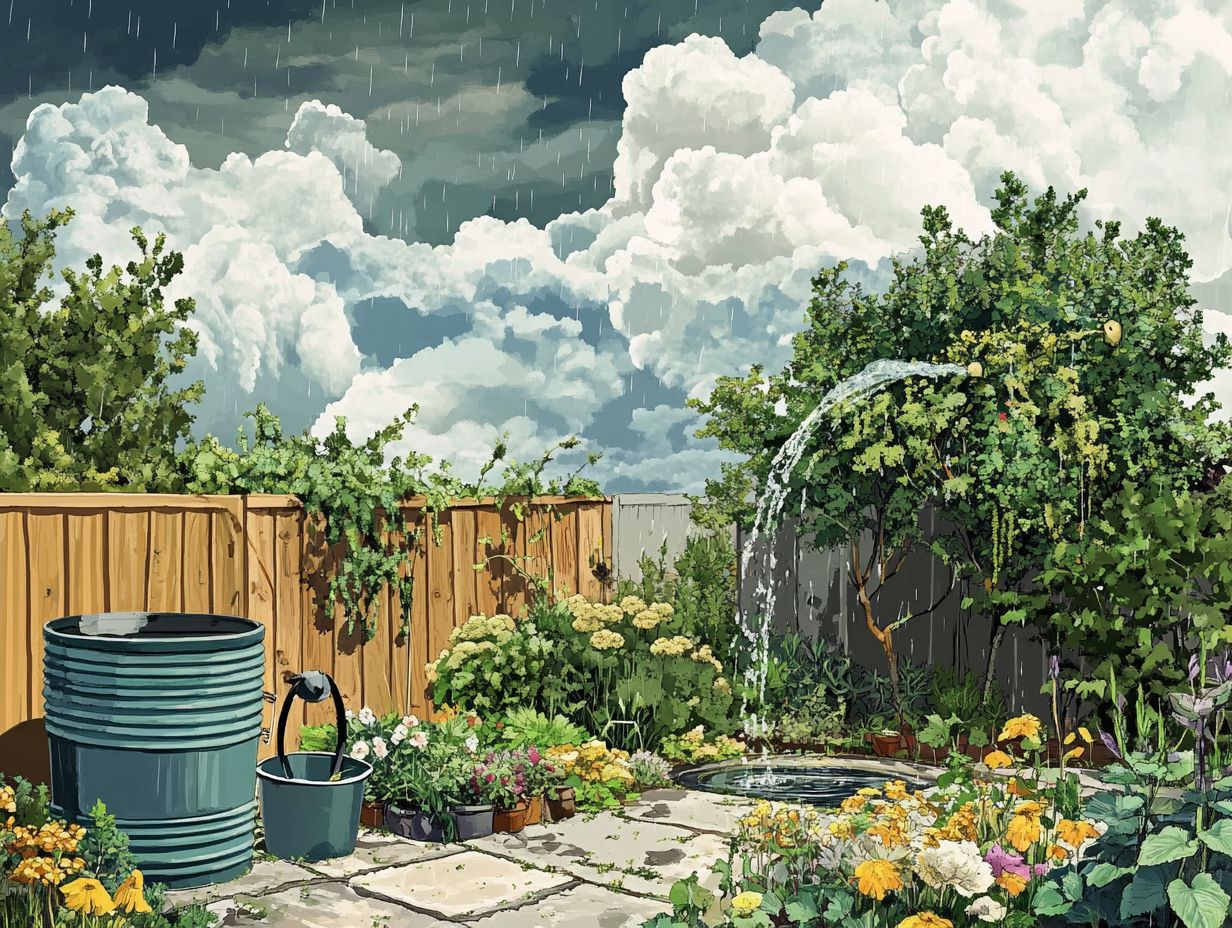
Collecting rainwater opens up a world of opportunities for you to save money, primarily by slashing those water bills while also reducing the need for washing windows and other household water needs. By reusing rainwater for irrigation, cleaning, and other household needs, it stands as one of the most cost-effective ways to manage your water resources.
Incorporating rainwater into your daily life promotes sustainability and boosts the health of your outdoor plants. Imagine setting up simple rain barrels beneath your downspouts, effortlessly collecting water during storms. This water can be used to nourish your gardens, wash your windows, or even refill bird baths, ensuring that every precious drop serves a purpose.
To maximize watering your plants, connect a soaker hose to the rain barrel to enhance absorption while minimizing waste. Repurposing this natural resource for outdoor cleaning tasks helps reduce reliance on potable water, leading to significant savings over time.
What Are the Different Ways to Use Collected Rainwater?
Collected rainwater offers a wealth of practical applications, such as irrigating gardens, washing windows, cleaning your car, and enhancing water features. This truly highlights the versatility of such a sustainable resource.
But that s not all rainwater is essential for nurturing your indoor plant setups, providing hydration full of nutrients for your houseplants and herbs. In outdoor spaces, you can easily install rain barrels to capture excess water during storms, creating a highly efficient irrigation system for your vegetable gardens or flower beds. Plus, it can refill ornamental ponds or fountains, lending a natural aesthetic while conserving municipal water.
To make the most of this resource, consider adding a simple filtration system, which is a setup designed to capture and store rainwater safely, for your gardening needs. You can even use it for pressure washing outdoor surfaces, ensuring you uphold your environmental responsibilities while keeping your home and landscape in impeccable condition.
What Are the Common Misconceptions About Collecting Rainwater?
Despite its myriad benefits, collecting rainwater often faces a cloud of misconceptions, especially regarding water quality and safety. These misunderstandings can dissuade you from adopting the sustainable practices championed by the Smart Water initiative.
You might think that rainwater is inherently unsafe, perhaps imagining it doesn’t have the purity needed for everyday use or even for your beloved garden. However, when harvested with care using appropriate materials and techniques, rainwater can serve as an excellent alternative to municipal sources.
By employing clean catchment systems and regularly maintaining your storage tanks, you can significantly boost the safety of your water supply. It’s crucial to filter and treat the collected water properly to minimize any potential contaminants a practice that numerous studies have shown to be both effective and reliable.
With the right rainwater harvesting practices in place, you can enjoy a sustainable and safe resource that not only meets your needs but also contributes positively to the environment. Start your rainwater collection journey today and make a difference!
How Can You Get Started with Collecting Rainwater?
Getting started with collecting rainwater is easier than you might think. It involves a few straightforward yet impactful steps:
- Selecting the right rain barrel.
- Ensuring your gutters are clean.
- Deciding between traditional methods and innovative techniques that align with your needs.
Start by researching different rain barrels. Consider factors such as size, material, and capacity to find one that perfectly fits your space and budget.
Next, maintain the cleanliness of your gutters, as this is vital for the quality of the water you collect. Regular cleaning helps avoid debris that can contaminate your harvested rainwater.
Take the time to explore different rainwater harvesting systems like rain gardens, cisterns, or permeable pavements, each offering unique benefits. By carefully looking at your choices, you ll discover methods that empower you to conserve water and reduce your ecological footprint.
Frequently Asked Questions
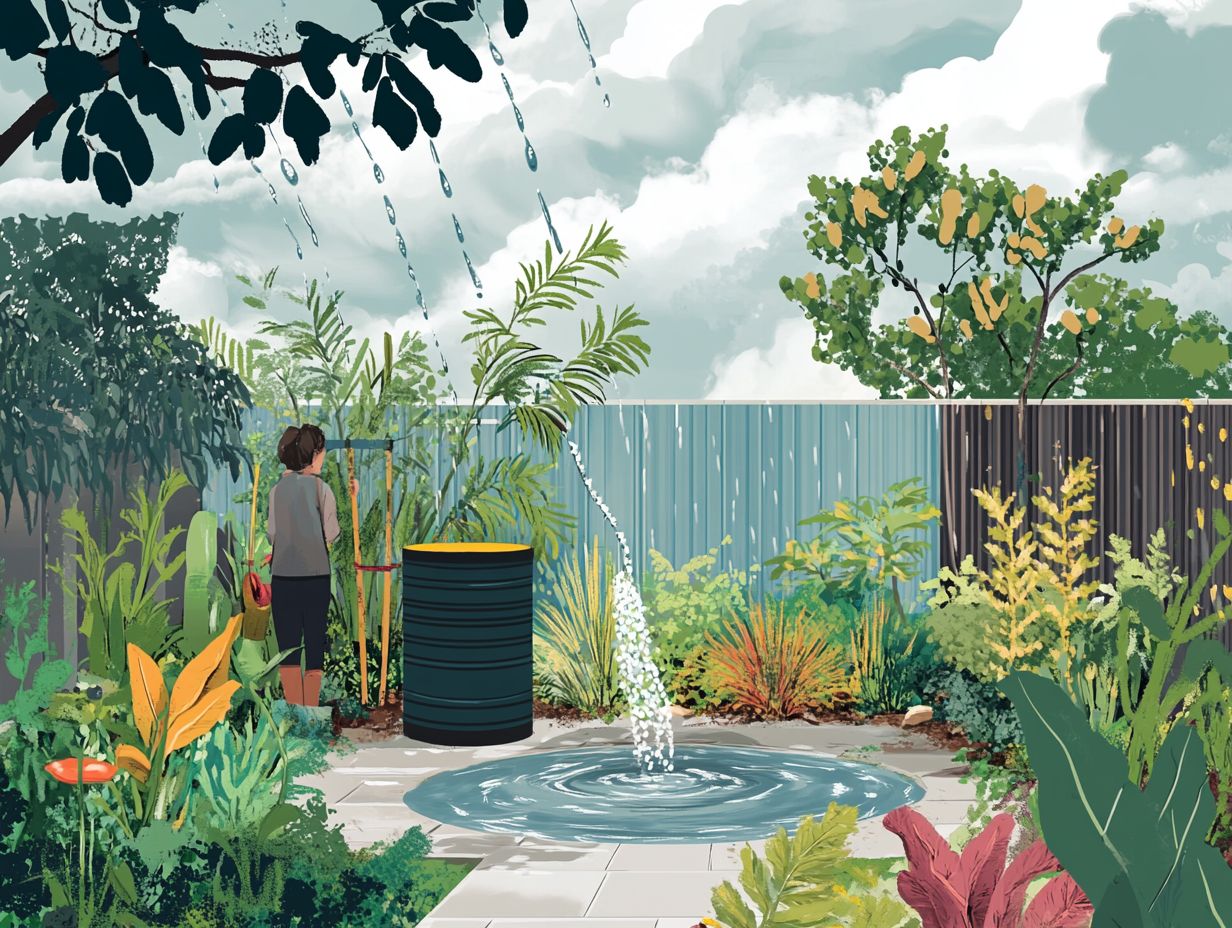
What are 5 creative ways to collect rainwater?
1. Installing a rain barrel: This is an easy way to collect rainwater for your plants or car.
2. Constructing a rain garden: Create a shallow depression in your yard to collect rainwater, which can then be used to water plants.
3. Building a green roof: A great option for those with flat roofs. The vegetation absorbs rainwater, reducing runoff.
4. Using a rainwater harvesting system: This collects and stores rainwater for future use, such as watering gardens or flushing toilets.
5. Creating a permeable driveway: Instead of concrete or asphalt, use permeable materials that allow rainwater to seep into the ground.
How can collecting rainwater benefit the environment?
Collecting rainwater helps reduce strain on local water sources and minimizes stormwater runoff, which can carry pollutants into rivers and streams.
Is it legal to collect rainwater?
The legality of collecting rainwater varies by location. Check with your local government to see if there are any restrictions or regulations in place.
What are the cost benefits of collecting rainwater?
Using collected rainwater for tasks such as watering plants or washing cars can save you money on your water bill. Additionally, some local governments offer incentives or rebates for installing rainwater harvesting systems.
How can I ensure the collected rainwater is safe to use?
It is important to properly filter and treat rainwater before using it for drinking or cooking. You can use rainwater for other purposes, such as watering plants or flushing toilets.
Are there any tips for maintaining my rainwater collection system?
Regularly clean and maintain your system to prevent clogs and ensure the water is free of debris. Properly winterize your system to prevent freezing during colder months.


